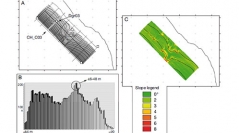

 Geodiversitas
34 (1) - Pages 77-98
Geodiversitas
34 (1) - Pages 77-98On the continental shelf off the Cilento peninsula (eastern Tyrrhenian Sea) the occurrence of more than 13 km2 of maerl beds was documented through acoustic surveys. Swath bathymetric data along with a dense grid of chirp-sonar profiles were acquired over more than 180 km2. The maerl facies was characterized on the basis of the components analysis of 32 grab samples collected at selected sites. Mapped maerl-beds are predominant on submerged terraces located at variable water depth (wd) between 42 and 52 m. This preferred distribution on submerged terraces is probably associated with relatively vigorous bottom currents generated by local circulation that hinders the deposition of terrigenous sediments. Calcareous red algae result to be the most important producers of carbonates from 40 down to 60 m wd. We calculated the coralline carbonate accumulation from the percentage cover of coralline algae (thin section mapping) × 1 cm-thick layer of sediment × measured coralline density. The total coralline cover (living plus dead) in the Cilento area is 13.96 km2, with a total 316 800 tons of algal carbonate in the surface 1 cm layer, that correspond to 20 430 g m-2. Living maerl is recorded at a depth of 47 m, with a live coralline cover of about 40% over a minimum area of about 1.2 km2. This live maerl has a thickness of about 1 cm and is composed mainly of unattached branches of Lithothamnion corallioides (P.L.Crouan & H.M.Crouan) P.L.Crouan & H.M.Crouan, 1867. The molluscan association of the maerl bed is dominated by characteristic species of the Coastal Detritic Biocoenosis. The production of carbonate by living coralline algae has been calculated as weight of live corallines in 1 cm-thick layer × 100 y-1 × total area-1 and corresponds to 90.8 g m-2 y-1.
seafloor mapping, submarine geomorphology, marine terraces, acoustic facies, maerl distribution, coralline carbonate, Cilento peninsula.